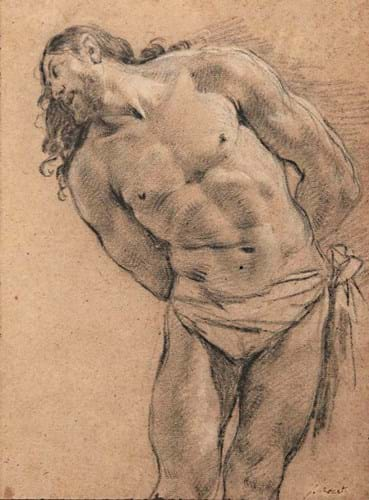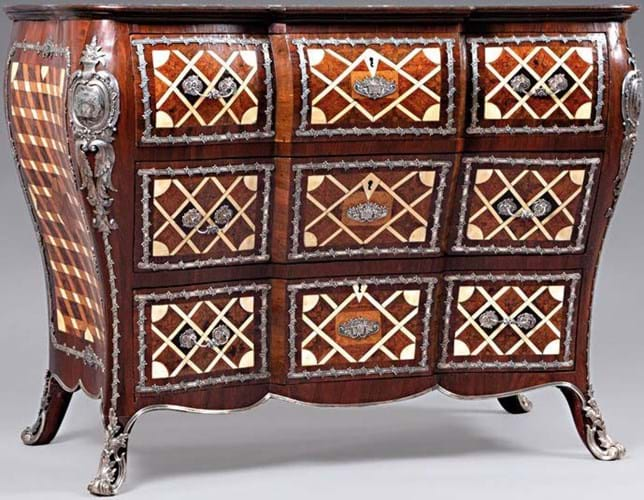An ancient Egyptian bronze model of a cat, an Old Master drawing by Rubens and a commode that belonged to Catherine the Great were among the best-sellers in the multi-discipline auctions offered at the Drouot auction centre in March. Pictured and discussed here is a selection from these recent sales.
Old Masters
Kâ-Mondo’s (26% buyer’s premium inc VAT) sale of Old Masters, furniture and works of art held on March 26 opened with a selection of Old Master drawings that had come from the collection of Jean-Baptiste-Florentin-Gabriel de Meryan, Marquis de Lagoy (1764-1829), who came from Arles in Provence.
At one point the marquis owned more than 3000 drawings by 870 different artists including works by Raphael and Michaelangelo. In 1820 he sold a selection of these to the English agent Woodburn. These were subsequently owned by Sir Thomas Lawrence and most of them ended up in museums such as the Ashmolean and the British Museum.
A sale of other drawings from the marquis’ collection took place in Paris in 1834 but the items offered here had been retained by the family and passed down by descent.
The high-flyers in this ensemble were a chalk drawing by the 17th century French artist Simon Vouet (1590-1649) and a pen and ink drawing made by Peter Paul Rubens (1577-1640) for a series of engravings to illustrate a scientific work.
The hitherto unpublished Vouet drawing, in black chalk with white chalk highlights measuring 11½ x 8¼in (29 x 21cm), depicts Christ at the Column and is inscribed lower eight in ink S Vouete. It is a preparatory study for a painting of the same subject in the Louvre and sold for €270,000 (£232,760) against an estimate of €100,000-150,000.
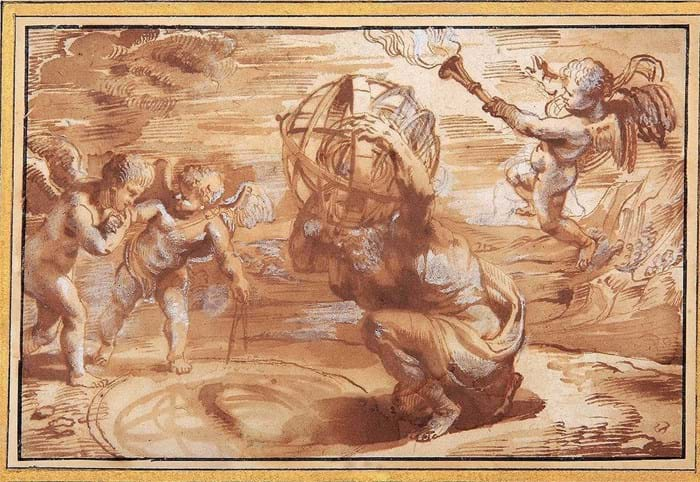
Rubens’ pen and wash study to illustrate François d’Aguilon’s l’Opticorumn Libri Sex – €240,000 (£206,895) at Kâ-Mondo.
The Rubens work, which measures 3½ x 5½in (9 x 14cm) is executed in pen, ink and brown wash with white chalk highlights. It is a vignette study for l’Opticorum Libri Sex, a six-part scientific work on optics from 1613 by the multi-talented Franciscus Agulonius or François d’Aguilon (1566-1617), an architect, mathematician, physician and theologian.
Rubens, who was a friend of Aguilon, was commissioned to produce six drawings and a frontispiece which were engraved to illustrate this important treatise. Three of the original studies are in the British Museum and the National Gallery of Art in Washington.
The Kâ-Mondo study for part six of the treatise depicts a scientist as a kneeling man holding up an armillary sphere to study the projection of shadows surrounded by three putti ‘assistants’. It sold within estimate at €240,000 (£206,895).
Early works of art
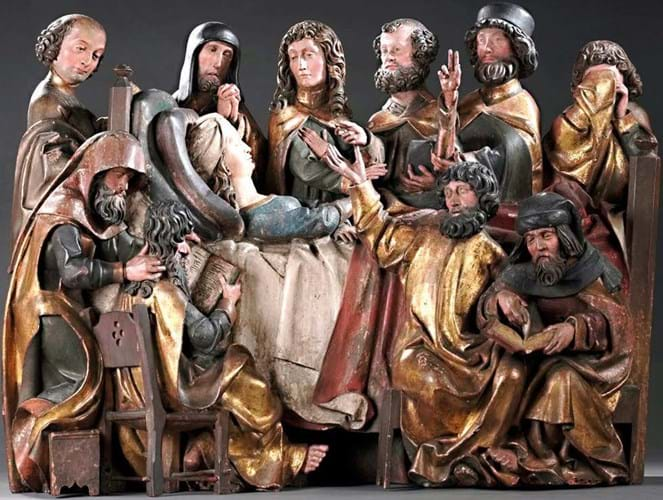
16th century carved limewood sculptural group of the Dormition of the Virgin – €350,000 (£310,724) at De Baecque at Drouot.
The highlight of a mixed-discipline sale held by De Baecque & Associés (27% buyer’s premium) on March 19 came from the sculpture section.
This was a piece of mediaeval wood carving, a large multi-figure group representing the Dormition of the Virgin and showing a recumbent figure of Mary surrounded by 10 of the apostles.
The sculpture, created from two individual blocks of limewood probably cut from the same tree, measures 3ft (92cm) in length and 2ft 3in (70cm) in height, is dated to the first quarter of the 16th century and originates from Schwabia or the Upper Rhine area.
The carving would originally have formed part of a large altarpiece and is notable for the individualisation of the different apostles. It also retains some of the original polychrome decoration. The sculpture has a provenance to the family of Louis Loucheur (1872-1931), by descent.
Estimated to make €50,000-80,000, it was pursued on the day to no less than €350,000 (£310,724).
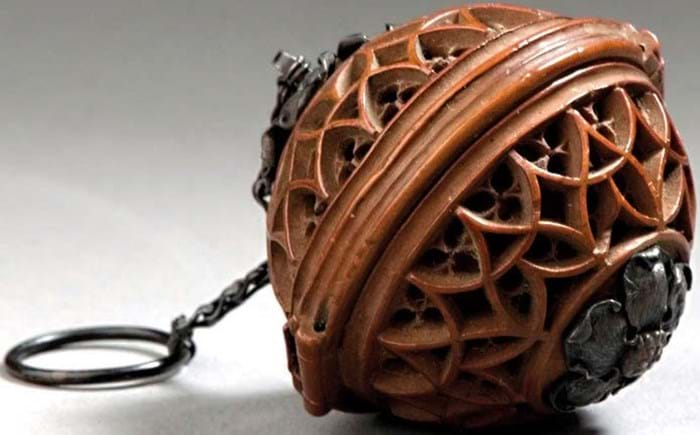
Open and closed views of a miniature 16th century boxwood carving containing a Nativity scene – €68,000 (£58,620) at De Baecque at Drouot.
Also making considerably more than predicted was the previous lot, a tiny early 16th century boxwood prayer nut.
This little microsculpture, measuring just under 1½in (3.5cm) in diameter, consists of two hemispheres carved with gothic tracery hinged together and opening to reveal a finely detailed carved scene of the Nativity encircled by biblical inscriptions. A second carved scene originally present is now missing with only the inscriptions retained.

Open and closed views of a miniature 16th century boxwood carving containing a Nativity scene – €68,000 (£58,620) at De Baecque at Drouot.
The carving is ascribed to Adam Dircksz and his workshop in the northern Netherlands, a reference to the only known signed example of this type of object. The workshop specialised in microsculpture carved from boxwood such as miniature altarpieces, rosaries and prayers nuts, over a relatively short period from 1500-1530.
Estimated to make in the region of €5000-8000, that guide was overturned with the hammer finally falling at €68,000 (£58,620).
Goddess as a cat
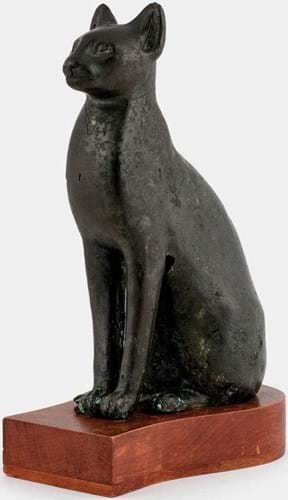
Votive bronze of the goddess Bastet in the form of a seated cat – €390,000 (£336,205) at Beaussant Lefèvre.
The highlight of a 231-lot sale of works from the collection of Sylvia Wildenstein held by Beaussant Lefèvre (14.28% buyers premium) on March 19 was an Egyptian antiquity: a votive bronze of the goddess Bastet in the form of a seated cat.
The 13¼in (34cm) high bronze feline is incised with well-defined whiskers, a scarab to the top of the head and a necklace with a heart-shaped pendant and has pierced ears. The statue was dated to the Saite or Late period 16th-30th dynasty (c.664-332BC) and the core has undergone a thermoluminesence test confirming it as between 2000-2600 years of age.
Estimated to make between €60,000-80,000, it somersaulted over that guide on sale day to sell for €390,000 (£336,205).
Furniture focus
A richly decorated marquetry commode made in Russia that belonged to Catherine the Great was the toast of a sale of drawings, paintings, furniture and works of art held by Gros et Delettrez (30% buyer’s premium) on March 23.
The three-drawer curved front commode, measuring 3ft 4in (1m) in width and dated to c.1762-65, was veneered in distinctive parquetry and marquetry in a variety of exotic woods including rosewood, karelian birch, violet wood and ebony and had embossed and chiselled silver mounts.
The top was inlaid with a medallion bearing the cypher of Catherine II of Russia while the front corners featured the arms of Siberia surmounted by the double-headed eagle and the tsarina’s cypher. The arms of Siberia also feature on the silver mounts to the angles.
There had been some later alterations, notably to the lower half of the commode and the feet.
A very similar commode, also with the cypher of Catherine the Great and the arms of Siberia, is kept in the Hermitage in St Petersburg.
The commode up at auction belonged to Catherine the Great then to the Demidoff family, to Princess Aurora Demidoff (1873-1904), and appeared at auction in 1969 when Sotheby’s sold the contents of the Villa Demidoff at Pratolino near Florence. It then belonged to Prince Paul of Yugoslavia (1893-1976), the son and heir of Princess Demidoff, who sold it to the businessman and collector Commandant Paul Louis Weiller in 1973.
At Gros et Delettrez it sold for €250,000 (£215,520), the low estimate.
£1 = €1.16


